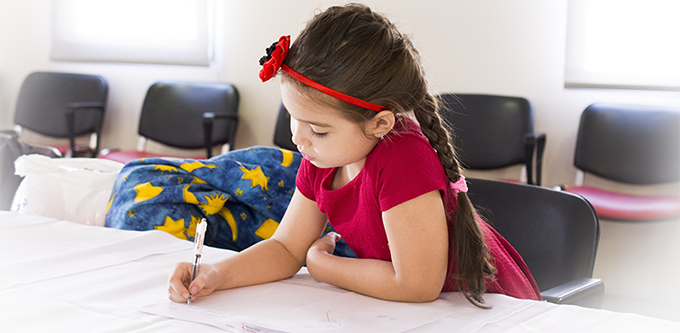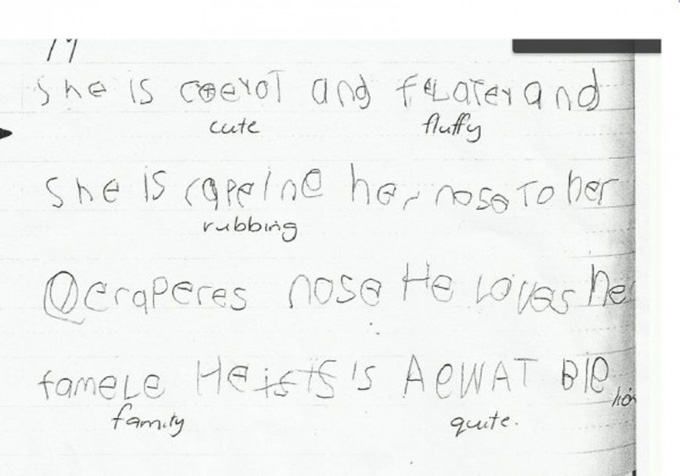
Students’ education has been disrupted around the world by the Covid-19 crisis. In France, distance education imposed by confinement situations has thus increased educational inequalities linked to the social origins of children and adolescents. Beyond the digital divide relating to the material conditions of equipment, the differences in the uses of language, orally and even more so in writing, have undermined the possibility of educational continuity for children from of the most popular backgrounds.
Training, reviews, exercises: these remote activities recommended by the Ministry of National Education, possible with sufficiently old pupils, can be based on the common experience developed in class with the teachers, or on the skills of the parents in certain case. In CP class, on the other hand, with six-year-old pupils who do not yet know how to read and write, how can you train in writing outside the classroom when the children have not mastered the basics? Especially if the parents do not read French fluently?
The two months of confinement in the spring of 2020 reminded us of the complexity of writing and uses: writing has many components, material, graphic, linguistic. If we want true equity between children from different socio-cultural backgrounds, these must all be taught by an expert adult.
Teaching, supporting the learning of writing requires real professional skills: ways of saying and doing, ways of showing and approaching knowledge, which the sciences of education, drawing inspiration from the field of ergonomics, call “professional gestures” .
Bounce back from error
The digital tools offered by the Ministry of Education (digital work environment, academic mailboxes, various padlets) involved an inhibiting use of writing for some parents, who did not master their language codes or spelling standards. The use of YouTube channels created for the occasion or applications like WhatsApp has made it possible to be as close as possible to their daily lives and to keep oral language as a means of communication despite the distance.
However, many obstacles have arisen in learning to write since the classes have ceased to bring together within their walls the children who usually rubbed shoulders there.
One of the biggest misunderstandings about school and teachers’ expectations of writing is that very early on, in the first years of learning, children should master spelling and spelling. Thus, often, the writings of the pupils during confinement were erased, corrected or even rewritten by an adult before being sent to the teacher or the schoolmistress. But by making errors disappear, we erase the exact place where teaching should concentrate, and we prevent learning.
The way of dealing with errors is indeed a fundamental professional gesture that serves the learning of students. Learning to write a text requires making mistakes, understanding the reasons for failure thanks to an adult who will explain the ways to overcome obstacles, the procedures to get there: do you have to pronounce the word to be able to write it? Do you have to know it by heart? Does what is written allow a third party reader to understand what we wanted to express? What is correct, incomplete or wrong in product testing?
If some had forgotten it, confinement reminded us of the obvious: the classroom is a place where individuals, teachers and learners, share space, equipment, the position of bodies and objects. Entry into the written world is marked by learning to use writing media and its tools: notebooks, sheets, books, lines, paper or colored pencil, pen.
In class, the six-year-old child tames this new lexicon, supported by the professional gestures of the teacher who will help to take out the right notebook, open to the right page, isolate the line, then who will reformulate the instructions, will ensure that the pencil is well sharpened or the pen is the right colour.
The co-presence of bodies makes it possible to best teach how to draw a letter, to observe the adult hand which draws and to listen to verbal indications. Even with audio and video support, the training sessions give heterogeneous results, depending on the support provided by the families, depending on the student’s degree of appropriation of class habits, which are not yet created for everyone during the year. of CP.

Training in writing the letter B, with the use of a video support: production of Alice on the left and Dozan on the right. Provided by the author
Surrounded by his peers and the teacher, the student gradually begins to speak a school language, he can mobilize other tools.
How to memorize the fact that the letters C and H placed side by side are pronounced “ch” as in “cat”? On the walls of the CP class, the phonological displays are visual aids which make it possible to associate a drawing of “cat” with the two letters CH, drawn in script and cursive, and the verbal and body language of the teacher makes explicit the how to use them, by words and by gestures which point, which focus the attention.
Learn with peers, from peers
One of the greatest assets of the school lies in the fact of being able to learn with many other individuals of the same age. Classmates have a fundamental role in learning to write, since we write to be read. The relationship to knowledge is symmetrical to that of classmates, everyone gropes, traces, inevitably makes mistakes, which makes it possible to desacralize errors and learn by commenting, arguing, proposing solutions. It is still necessary that the teacher give birth to these exchanges, keeping the course of knowledge targeted.
Research carried out in didactics shows the importance of “feedback” in the learning process of the complex and very powerful cultural tool that is writing. How can the child build landmarks, situate himself in the long appropriation of this tool, be sure of what he already knows, in order to rely on it to continue to conquer writing? Language feedback, verbal or bodily but always explicit, are professional gestures that teachers cultivate in their own practice and develop in the same way in their students. The workshops and writing sites allow learning for older students, from 10 to 12 years old.
But also from first grade, the words or small texts produced by the children can be given to their classmates to read: the class tries to understand the ideas, reports on what has been written and which is not readable, not decipherable, not comprehensible. This device for teaching writing and proofreading, combined with the professional gestures of the teacher, is part of the tradition of the pedagogue Célestin Freinet , who saw education as a means of emancipation and accorded a central place to students’ writings.
The child writer can thus put his writing at a distance, learn to read again by seeing his essay through the eyes of others. He recognizes his mistakes and his successes in those of others. When the child does not do it or not consciously, it is then up to the teacher to point it out, to explain it. All this oral language, created around the writings of children, groping and gradually becoming more assured, is a source of learning and evolution.
Teaching writing in all its complexity
Because the difficulty of teaching to write or read lies in the very complexity of writing. This complexity is obvious to the adult who tries to make a six-year-old child write: at that age, the child does not always know how to trace the letters in the right direction, to link them to each other.
Sometimes he doesn’t hold his pen well yet, doesn’t know what to do when there’s no more room on the line. He did not always understand the alphabetic principle, the fact that each sound that one pronounces can be translated by one or more letters. He knows even less that many words, in French, cannot be written by listening to the sounds that compose it, because they are too irregular: one can listen to “caravane” to write it, but not “today”, which you will have to know by heart.
Some children simply don’t dare to write because they don’t know how to write yet, or because their parents never do. Some write without realizing that their writing does not answer the question asked, thus placing themselves “off topic”.
The role of the teacher is thus to propose a progressiveness in the sum of the knowledge to be mastered, whether it be those relating to the graphic, semantic or affective component. It provides a space where children can co-construct knowledge, where writing is no longer an object of inhibition or even anxiety for anyone but on the contrary a means of expression and emancipation that will make each child a reflective and equipped individual.
Author Bio: Veronique Magniant is a PhD student University of Bordeaux at LABE3D at the University of Bordeaux
